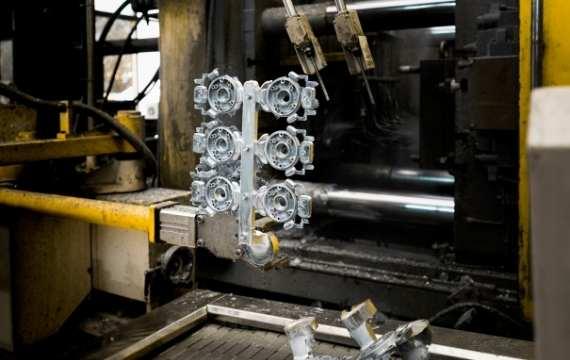1 minute to comprehend the fundamental information regarding aluminum alloy die-casting molds

The manufacturing of molds encompasses not only the production of shearing dies and die-cutting dies, but also the processing of forming and billet tools. In most cases, the die will consist of an upper die as well as a lower die. The steel plate is positioned so that it is sandwiched between the upper and lower molds before the material is subjected to the press and given its final shape. When the press is opened, either the workpiece whose shape was determined by the mold or the waste that corresponded to the shape of the mold is removed. Molding can be used to create pieces of work as small as electronic connectors and as large as dashboards for automobiles.
1. Tremendous dimensions and load
When processing large molds, processing companies face a significant challenge in determining how to deal with the enormous size and weight of the molds themselves. The processing of large molds typically requires a significant amount of labor, specialized equipment, multiple rounds of debugging, and CNC machining parts multiple rounds of clamping. Additionally, the accuracy of the processing can be affected by a wide variety of potential factors and is difficult to guarantee.
2. Problems with the costs of acquisition
The purchase price of machine tools constitutes the single largest expense that is directly connected to the processing and production of a variety of large molds. Machine tools that are capable of producing large molds are quite expensive, particularly under complex process arrangements. Because of this, it is necessary to use multiple machine tools in order to finish the entire process of roughing and finishing molds. The fact that there is such a high initial investment cost is also the primary barrier that prevents many businesses from entering this market. Because of this, it is clear that many issues will be resolved, and the accuracy of the machining can be ensured, if the rough machining and finishing of large molds can be accomplished on an appropriate machine tool. Even if only one debugging and clamping is required, this will result in a significant time savings.
The machine tool spindle features a cast iron bed structure and is equipped with a heat dissipation function.
Cast iron is the most stable material for manufacturing machine tool structural parts because of its high level of rigidity and its ability to dissipate heat. To begin, any machine tool that is intended for milling substantial components must initially have a construction made of very sturdy cast iron and be outfitted with a cooling spindle.

When it comes to the machine tool's spindle, the device needs to have a built-in cooling technology that can cool the spindle from the outside of the bearing. This is necessary to ensure that the spindle itself will not be destroyed by overheating or that the accuracy will not be compromised as a result of thermal expansion during extended periods of processing.
These aspects are of utmost significance due to the fact that the machining of large molds takes a considerable amount of time and, under heavy cutting conditions, causes an increase in both the mold's temperature and its level of stress. In order to process large-scale aluminum alloy die-casting molds of high quality, the structural components of the machine tool CNC machining need to have good rigidity and heat dissipation characteristics. This is the prerequisite for the processing of the molds. As a result, it is essential to put as much of a cap as possible on the amount of vibration that the machine tool experiences during the process of machining and to rapidly dissipate the heat that is generated during the process of machining. If the appropriate processing machine tools and cutting tools are selected, it is possible to achieve a situation in which both the cost and the cycle time are optimized.
Because heat stabilization technology requires a lengthy processing time, it is imperative that the impact of the surrounding temperature be taken into account. For instance, when a large aluminum alloy die-casting mold is processed on an ordinary machine tool, the temperature of the column of the machine tool will change by 6 degrees Celsius whenever there is a change of 10 degrees Celsius in the ambient temperature. This will result in a change of 0.07 millimeters in the parallelism of the spindle angle plate. As a result, the design of the machine tool must take into account the effect of the ambient temperature so that the accuracy of the machined parts is not impacted by the temperature of the surrounding environment.
3. Velocity
For a large-scale mold processing center with a stroke that can move quickly, the spindle speed of the large-scale mold processing machine tool should reach at least 20,000 revolutions per minute, and the metal cutting speed should meet between 762,000 and 200,000 millimeters per minute (mm/min).
4. Preciseness
Every stage of the molding process is subject to stringent precision control. When it is necessary to perform rough machining and finish machining of large molds on the same machining center, it is imperative that the positioning accuracy and repeat positioning accuracy of the machine tool be strictly controlled. When it comes to machining centers that are specifically designed for making large molds, the positioning accuracy can generally get as high as 1.5 m, while the repeat positioning accuracy should get as high as 1 m. At the same time, the accuracy of its pitch ought to be maintained within 5 micrometers.
5. the resolution of feedback
The feedback resolution of the machine tool itself is very important for determining the accuracy of the machined parts when performing high-precision curved surface processing. When the feedback resolution is set to the standard 1 m, the results aluminum casting that are obtained are frequently not very satisfying. If the resolution can get down to 0.05 micrometers, then the finished product will have very few defects. In addition, the processing quality of the part surface can be improved even further by controlling the machine tool's resolution, utilizing scale feedback, and utilizing a small-pitch ball screw.
6. Spinning wheel

As a reference standard, the surface machining quality that can be achieved should be controlled at the level of 2 micrometers, and the spindles that are used on large mold machining centers need to meet the requirements for rough machining, semi-finishing, and high-quality finishing. In most cases, the finishing of the mold closing surface and the parting line is of the utmost importance; however, in the traditional manufacturing process, many mold manufacturers are required to use manual polishing to compensate for the lack of accuracy in the tool machining process. It is obvious that it is not practical to purchase multi-functional machine tools for this process as the cost of large-scale processing machine tools is expensive.
In addition, a good spindle design should extend the life of the tool as much as possible by ensuring that it continues to function during the machining cycle with a minimum amount of vibration and an increase in temperature. For instance, when processing automobile instrument panel molds on large-scale mold processing centers, the processing speed can reach 8 meters per minute if 16 mm CBN inserts are used to finish the machining tools. Additionally, the service life can exceed 30 hours, and the processed surface quality can be controlled at 0.336 to 3.2 micrometers. It is clear that, taking into account the rise in tool costs that occurs when processing large molds, the utilization of large mold processing machine tools that are specifically designed can not only extend the useful life of the tools, but they can also significantly reduce the amount of money spent on tool usage for the processing of each mold.





